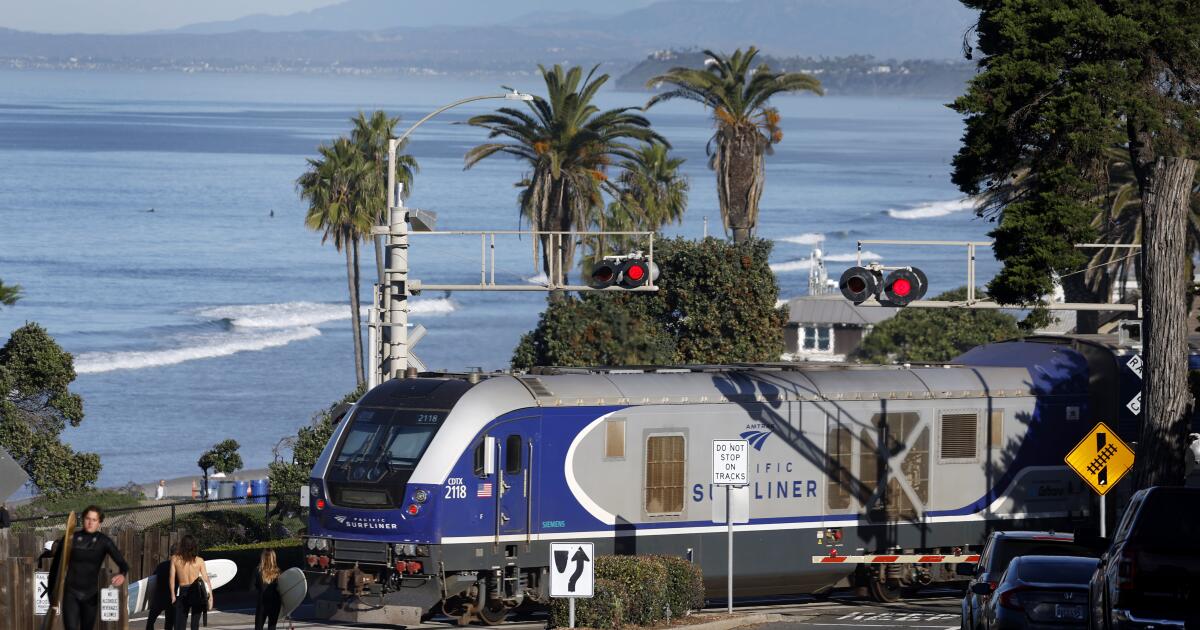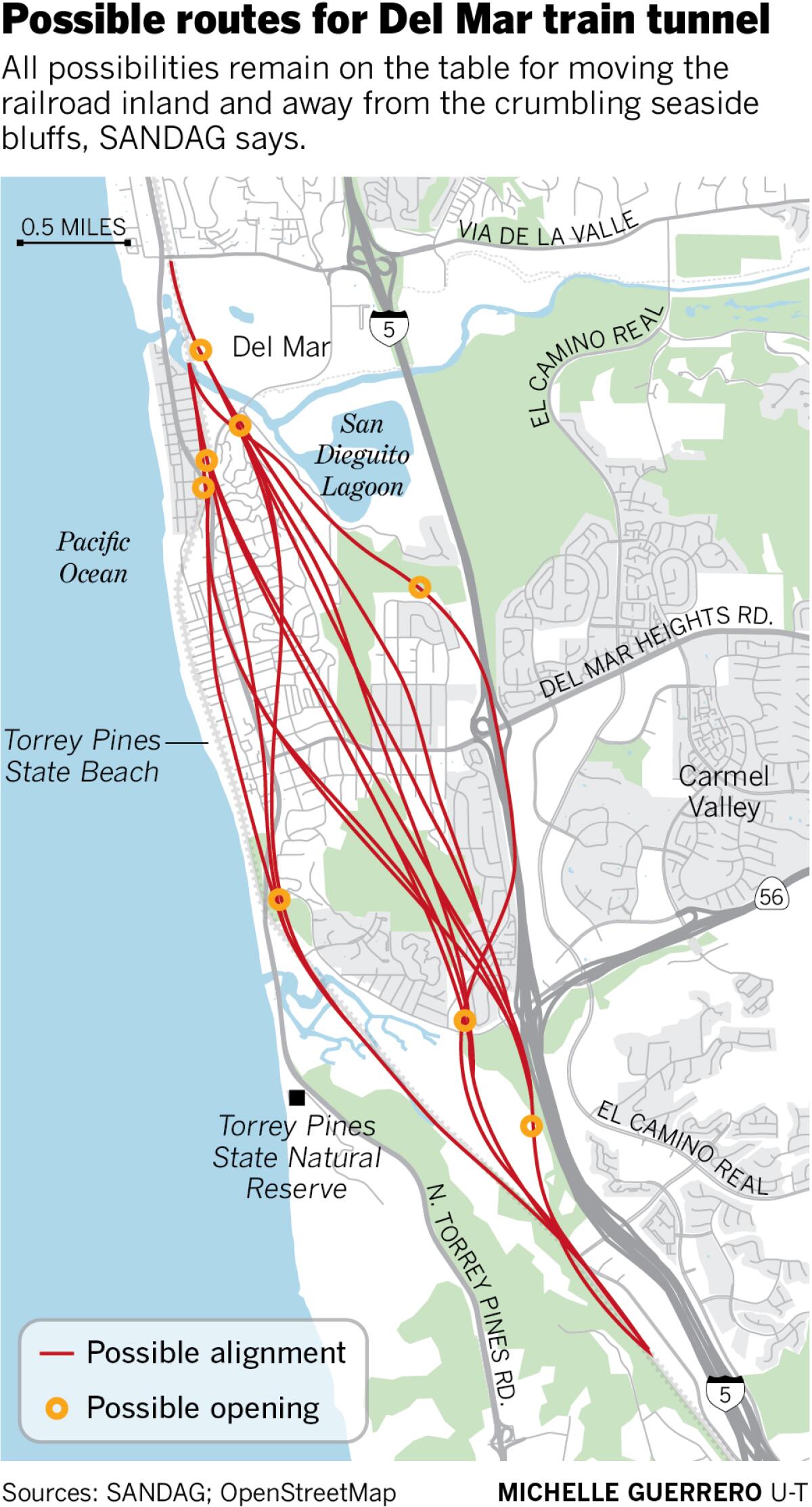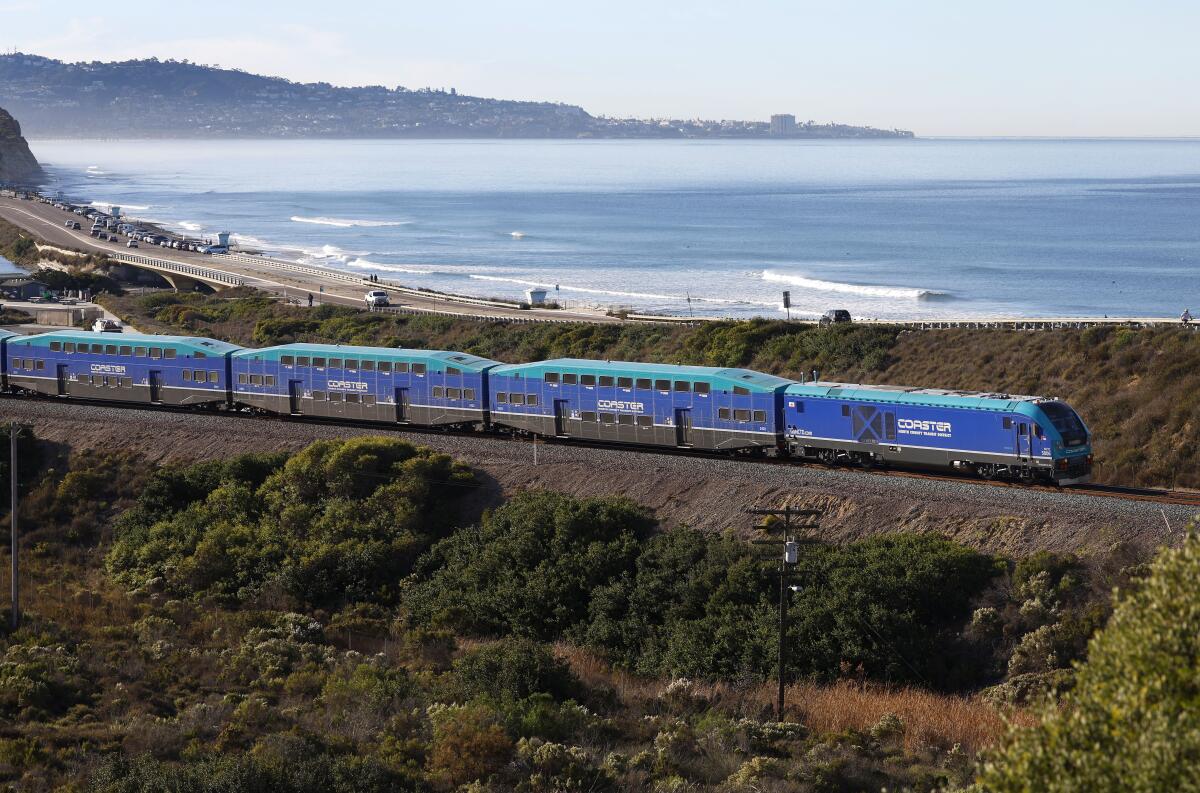
First there was a map with five possible routes for a tunnel to take the train tracks off the eroding Del Mar bluffs.
Then the San Diego Association of Governments, the region’s planning agency, announced it had narrowed the possibilities to two routes. That changed after many Del Mar residents objected to the idea of boring the passageway beneath their homes.
Now there’s a whole “spaghetti map” of routes, the original five plus a half-dozen more, and additional studies, public meetings and outreach programs are planned. Among the newest possibilities is one proposed by the Del Mar City Council that would take the trains across the nearby state fairgrounds.
“Back in 2017, we said there’s five lines on a map,” said Robin Wagner, SANDAG’s marketing and communications manager, at a recent community meeting.
“A few years later, we did an analysis and said, OK, now we’ve got two lines on a map,” Wagner said. “And then we came back this year and said, no, nothing is decided, we’ve got a whole bunch of lines on a map … that’s sort of the process that the project goes through.”

Planners are listening to community input, doing more analysis and will continue to learn about the project, she said. There’s what she called the spaghetti map of possible routes, adding that a final alignment won’t be chosen any time soon.
Most of the area’s elected officials agree with SANDAG administrators that about 1.6 miles of the train tracks eventually must be moved. The bluffs recede at a rate of 6 inches annually, and at some spots in Del Mar, the rails are just a few feet from the crumbling cliff.
Transit planners say the tracks are vital to Southern California commerce and transportation, despite what some naysayers may believe.
The railroad is part of Los Angeles-San Diego-San Luis Obispo corridor, known as LOSSAN, and a link in the Defense Department’s Strategic Rail Corridor network that connects military bases across the United States.
So far this year, the Port of San Diego has used the railroad to ship more than 2,000 pieces of military equipment including huge, box-like shipping containers, tanks, fighting vehicles, mine-sweeping gear and various rolling stock, port spokesperson Gabriella Rodriguez said in mid-November.
Civilian businesses have used the port to ship roughly 363 metric tons of “breakbulk” cargo such as heavy electric transformers by rail this year, Rodriguez said. Breakbulk is a term for large items shipped separately that don’t fit into shipping containers.
More than 146,000 automobiles have been shipped on trains from the port so far this year, Rodriguez said. Many of those are cars were built in Mexico by Honda, Chrysler, Volkswagen and General Motors. The port has the capacity to handle as many as 400,000 vehicles annually, and imports about 10 percent of the new vehicles sold in the western United States,
The vehicles arrive in San Diego on trucks and on chartered ships from ports in Mexico, Europe and Asia. They leave San Diego in specially designed rail cars operated by Pasha Automotive Services, a global company with offices at the Port of San Diego since 1990.
The LOSSAN corridor handles about $1 billion in freight and nearly 8 million passengers annually, with the majority of that traffic on rail segments between San Diego and Los Angeles, according to SANDAG.
“It’s our only rail link between San Diego and the rest of the country,” said Danny Veeh, SANDAG’s rail planning program manager. “It’s a vital piece of infrastructure for this region, and we have an obligation to maintain this rail corridor.”
Freight travels mostly by night, when few people can see it. Passengers travel by day, with peak volumes during commuter hours and for special events such as conventions and Padres baseball games.
Long-term plans call for service to increase to one Amtrak passenger train per hour, three Coaster commuter trains per hour, and a 33-minute travel time between Oceanside and San Diego, Veeh said.
“To do that we have to straighten curves and double-track the alignment,” he said, and the only way to do that is to move the tracks off the bluff and into a tunnel.
Double-tracking, or adding a second set of railroad tracks, increases capacity and efficiency. So far, about three-quarters of the San Diego County segment has been double-tracked. However, the narrow right-of-way at places like Del Mar creates bottlenecks that slow the entire corridor.
The initial five routes studied for the tunnel included two possibilities along Interstate 5. However, after preliminary studies, the I-5 proposals were dropped because they would take trains too far off the main route, adding to travel time and construction costs.
Del Mar residents have sought to move the tracks since the 1990s or longer. However, the realization that the new route could carry heavy freight trains beneath their homes raised concerns about noise, vibration, tankers of toxic chemicals and more.
A list of “guiding principles” for the relocation approved Nov. 13 by the Del Mar City Council states the top priority for realigning the route should be a tunnel along the I-5 corridor and beneath the Del Mar Fairgrounds, away from more residential areas.
However, the 22nd District Agricultural Association, which runs the fairgrounds, opposes taking the trains through the state-owned property.
Del Mar has been working with the 22nd DAA for more than a year to build the city’s state-mandated affordable housing on the fairgrounds, part of which is within the city. So far, no agreement has been reached.
“We have been pleased with the progress that we have made in these conversations, and we have moved forward with the consideration of affordable housing at the Del Mar Fairgrounds as part of our ongoing comprehensive planning process,” states a Nov. 9 letter to city officials from fairgrounds Chief Executive Officer Carlene Moore.
“As you know, SANDAG has already studied a possible LOSSAN alignment that would run underneath and through a portion of the Del Mar Fairgrounds,” Moore said. “That study found extensive issues with such a concept, and it has not been regarded as a particularly feasible option.”
Trains going into and out of a tunnel from a portal on fairgrounds property would leave no room there for affordable housing, Moore said.
“SANDAG’s existing assessment has allowed us to discuss siting affordable housing under the reasonable assumption that we would not host a portal opening or a train running somewhere through our property — and that we would not have years of potentially disruptive construction here while the tracks and/or portal were built,” she said.
Del Mar is San Diego County’s smallest incorporated city and one of its wealthiest. According to Zoom, the average home there is worth $3.6 million, and anything near the bluff-top railroad tracks is considerably more.
Most residents there have long supported moving the tracks, but concerns and even opposition has surfaced as plans grow more detailed.

A Coaster commuter train crosses Los Penasquitos Lagoon south of Del Mar on Wednesday, where the tracks could be relocated.
(K.C. Alfred/The San Diego Union-Tribune)
Homeowners have said a tunnel will cut their property values. Some people worry that tankers of toxic chemicals could derail beneath their houses, or that daily vibrations might shake their foundations.
People who could live near the entrance and exit portals, though the locations are yet to be pinned down, have voiced concerns about noise, fumes and the possibility of losing their homes to eminent domain.
Del Mar has the money and resources to fight. A North County Transit District proposal to build a chain-link safety fence along the railroad right-of-way in Del Mar has been stalled for years because the residents don’t want it, despite being completed along most of the county’s 60-mile corridor.
Councilmember Dan Quirk has emerged as a spokesman for the tunnel opponents, questioning the need for a construction project certain to cost $4 billion or more. He’s advocated for completely eliminating the train and turning the tracks into a bicycle and pedestrian trail.
Ridership statistics don’t justify the cost of a tunnel, Quirk has said multiple times at public meetings. His frequent attacks on SANDAG and NCTD have distanced him from the rest of the Del Mar council members, who say he doesn’t speak for them on issues related to the train.
“We are not in a position to determine whether this train should exist,” Del Mar Councilmember Dave Druker said at a recent meeting, adding that the city’s top priority should be moving the tracks inland.
“It is what I have been working on since 1995,” Druker said.
SANDAG and NCTD have said that though ridership has declined since the pandemic, the numbers are slowly increasing again and will grow faster as trains are added and service is improved.
Passenger train service will grow more important as freeways become more clogged and rail travel becomes more efficient, according to transit officials. Freight service fills a small, but vital niche that can be provided in no other way. And the military service is a federal obligation.
“Everybody that wants to get rid of this train doesn’t understand the agreement that NCTD has made,” said Encinitas Mayor Tony Kranz, a SANDAG board member and former NCTD board chair.
The transit district has contracts with BNSF and Amtrak, along with its designation as the Defense Department’s rail network, that require it to keep the train tracks operating with access to the Port of San Diego.
“Rail is not going away,” Kranz said. “It’s really silly to think of the notion of getting rid of the train.”
SANDAG received a $300 million grant from the state’s Transit and Intercity Rail Capital Program last year to complete preliminary engineering and environmental documents for the project. Planners including Veeh have said a tunnel is the only option available because of the steep terrain between two sea-level lagoons.
Planners are working to decide whether it will be one tunnel for two sets of tracks, or twin tunnels for separate tracks. A self-contained machine would be used to bore the tunnel horizontally from portal to portal reaching depths close to 300 feet.
“They are little factories that operate completely underground, so they are not impacting the surface,” Veeh said.
Work on a final design for the route should begin in 2026, he said. Construction could begin in 2028 and be completed in 2035.






